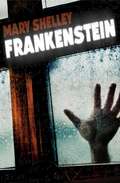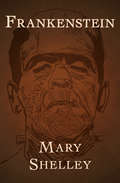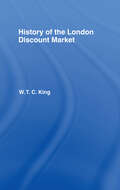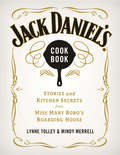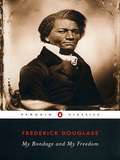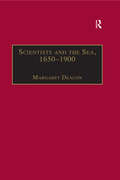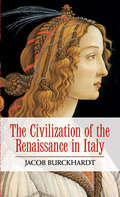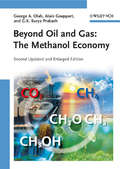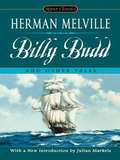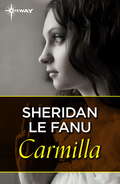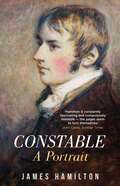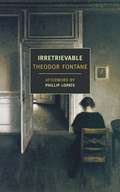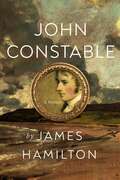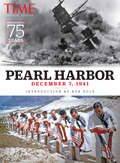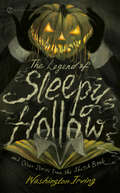- Table View
- List View
Frankenstein
by Mary ShelleyThrough letters sent by Robert Walton to his wife, a wandering figure emerges named Victor Frankenstein. Frail and nearing his death, Victor recounts a fantastical story of how he assembled old body parts to create a human-like being, a creature so utterly monstrous and hideous that he regretted being its creator. Frankenstein's rejection of his creation turns the 'creature' into a true monster, resulting in murder and havoc and a treacherous voyage to find and kill it once and for all. Frankenstein is a true classic of modern literature and is often considered to be a pioneering work of science fiction. Through Mary Shelley's extraordinary tale, we see the true reflection of the human condition, which demands wonder, fear and empathy.
Frankenstein (Regents Illustrated Classics)
by Mary ShelleyThe premier monster story of English literature—a tale of science pursued to horrifying extremes An origin story nearly as famous as the book itself: One dreary summer on the shores of Lake Geneva, amid discussions of galvanism and the occult and fireside readings from a collection of German ghost stories, Lord Byron proposed a game. Each of his guests—eighteen-year-old Mary Godwin and her future husband, the poet Percy Bysshe Shelley, among them—would try their hand at writing a tale of the supernatural. Unable at first to think of a plot, Mary was visited one sleepless night by the terrible vision of a corpse, a &“hideous phantasm of a man,&” lurching to life with the application of some unknown, powerful force. The man responsible, a &“pale student of unhallowed arts,&” fled in horror from his creation, leaving it to return to the dead matter from which it had been born. But the monster did not die. It followed the man to his bedside, where it stood watching him with &“yellow, watery, but speculative eyes&”—eyes of one who thought, and felt. The novel that Mary Shelley would go on to publish, the legend of Victor Frankenstein and his unholy creation, and their obsessive, murderous pursuit of each other from Switzerland to the North Pole, has been the stuff of nightmares for nearly two centuries. A masterpiece of Romantic literature, it is also one of the most enduring horror stories ever written. This ebook has been professionally proofread to ensure accuracy and readability on all devices.
History of the London Discount Market
by W. T. KingFirst Published in 1972. Routledge is an imprint of Taylor & Francis, an informa company.
Jack Daniel's Cookbook: Stories and Kitchen Secrets from Miss Mary Bobo's Boarding House
by Mindy Merrell Lynne TolleyIf youÆve ever ventured seventy miles south of Nashville to the quaint farming town of Lynchburg, you already know that it is justifiably famous for two things: Jack DanielÆs Old No. 7 and the legendary spread of Southern cooking at Miss Mary BoboÆs Boarding House. The recipes in this collection combine two of TennesseeÆs most celebrated cultural treasures into a guide for home cooks eager to capture the spirit of Lynchburg in their own kitchens. Written by Miss Mary BoboÆs own Lynne Tolley and food writer Mindy Merrell, this cookbook distills the essence of Lynchburg life into something tangible you can experience whenever you need it. Join Lynne, Jack DanielÆs own great-grandniece, as she shares family secrets, legacies, and heirloom recipes. Get a taste of life in the old Bobo Hotel, and discover how you can treat your own guests with the same trademark hospitality Miss Mary extended at her boarding house. YouÆll get a crash course in Southern cooking along the way, with a primer on the ingredients and techniques found in any good olÆ Lynchburg kitchen. From grits and ham hocks, to iron skillet seasoning and self-rising cornmeal, all the pillars of a country kitchen are covered. So push up your sleeves, pour yourself a tall glass of Lynchburg Lemonade, and get ready to whip up some Moore County favorites.
My Bondage and My Freedom
by Frederick DouglassThe second in the series of three autobiographies penned by Frederick Douglass, My Bondage and My Freedom picks up where Narrative of the Life of Frederick Douglass left off. This volume recounts more gripping details of Douglass' transformation from illiterate slave to leading light of the abolitionist movement and offers an extended philosophical meditation on the meaning of slavery.
Peter Cartwright, Legendary Frontier Preacher
by Robert BrayBelieving deeply that the gospel touched every aspect of a person's life, Peter Cartwright was a man who held fast to his principles, resulting in a life of itinerant preaching and thirty years of political quarrels with Abraham Lincoln. Peter Cartwright, Legendary Frontier Preacher is the first full-length biography of this most famous of the early nineteenth-century Methodist circuit-riding preachers. Robert Bray tells the full story of the long relationship between Cartwright and Lincoln, including their political campaigns against each other, their social antagonisms, and their radical disagreements on the Christian religion, as well as their shared views on slavery and the central fact of their being "self-made." In addition, the biography examines in close detail Cartwright's instrumental role in Methodism's bitter "divorce" of 1844, in which the southern conferences seceded in a remarkable prefigurement of the United States a decade later. Finally, Peter Cartwright attempts to place the man in his appropriate national context: as a potent "man of words" on the frontier, a self-authorizing "legend in his own time," and, surprisingly, an enduring western literary figure.
Rivers West
by Louis L'AmourHis dream was to build magnificent steamboats to ply the rivers of the American frontier. But when Jean Talon began his journey westward, he stumbled upon a deadly conspiracy involving a young woman's search to find her missing brother, and a ruthless band of renegades. Led by the brazen Baron Torville, this makeshift army of opportunists is plotting a violent takeover of the Louisiana Territory. Jean swears to find a way to stop this daring plan. If he doesn't, it will not only put an end to all his dreams; it will change the course of history--and destroy the promise of the American frontier.From the Paperback edition.
Scientists and the Sea, 1650–1900: A Study of Marine Science
by Margaret DeaconScientists and the Sea is a history of how the scientific study of the sea has developed over a period of nearly 2500 years. Beginning with the speculations of Greek philosophers it carries the story forward, showing how curiosity about the ocean appeared in many different forms and locations before, in the late 19th century, the first deep-sea researches heralded the foundation of the science known today as oceanography. Originally published in 1971, this book has never been superseded as the most comprehensive and wide-ranging treatment of the emergence of marine science within the western scientific tradition. After three introductory chapters dealing with knowledge up to the Renaissance, the main part of the work shows how pioneers of scientific observation at sea during the 17th and 18th centuries made notable discoveries, but that it was not until the middle of the 19th century when, aided by the advance of technology, scientists were able to undertake the first explorations of the ocean depths. This second edition contains a new introduction and bibliography.
The Civilization of the Renaissance in Italy (Modern Library Ser.)
by Jacob BurckhardtThis authoritative study by a distinguished scholar presents a brilliant panorama of Italian Renaissance life, explaining how and why the period constituted a cultural revolution. Author Jacob Burckhardt chronicles the transition from the medieval concept of society as a conglomeration of classes and communities to the Renaissance focus on individual spirit and creativity. Burckhardt's comprehensive view of art, government, and aspects of daily life redefined both the Western world's understanding of the Italian Renaissance and future studies of cultural history. Historian Hajo Holborn praised this survey as "the greatest single book on the history of Italy between 1350 and 1550." First published in German in 1860, its exploration of art, fashions, manners, and philosophy traces the influences of classical antiquity on Michelangelo, Leonardo, the Medicis, and other thinkers and artists. As alive today as when it was written 150 years ago, this indispensable study chronicles the revival of humanism, the conflict between church and empire, and the rise of both the modern state and the modern individual.
The Realist Novel (Approaching Literature)
by Dennis WalderThis book guides the student through the fundamentals of this enduring literary form. By using carefully selected novels and discussing a wide range of authors including Emily Dickinson and John Kincaid, the authors provide a lively examination of the particular themes and modes of realist novels of the period. This is the only book currently available to provide such a wide range of primary and secondary material and is the prefect resource for a literature degree.
Beyond Oil and Gas
by George A. Olah G. K. Prakash Alain GoeppertThe world is currently consuming about 85 million barrels of oil a day, and about two-thirds as much natural gas equivalent, both derived from non-renewable natural sources. In the foreseeable future, our energy needs will come from any available alternate source. Methanol is one such viable alternative, and also offers a convenient solution for efficient energy storage on a large scale.In this updated and enlarged edition, renowned chemists discuss in a clear and readily accessible manner the pros and cons of humankind's current main energy sources, while providing new ways to overcome obstacles.Following an introduction, the authors look at the interrelationship of fuels and energy, and at the extent of our non-renewable fossil fuels. They also discuss the hydrogen economy and its significant shortcomings. The main focus is on the conversion of CO2 from industrial as well as natural sources into liquid methanol and related DME, a diesel fuel substitute that can replace LNG and LPG. The book is rounded off with an optimistic look at future possibilities. A forward-looking and inspiring work that vividly illustrates potential solutions to our energy and environmental problems.
Billy Budd and Other Tales
by Herman MelvilleWith an introduction by Joyce Carol OatesCollected here are the legendary American author's novella, Billy Budd, and his short stories: "The Piazza," "Bartleby, the Scrivener," "Benito Cereno," "The Lightning-Rod Man," "The Encantadas," "The Bell-Tower," and "The Town-Ho's Story" (from Melville's masterpiece, Moby-Dick).
Billy Budd, Sailor (Enriched Classics #Vol. 3)
by Herman Melville<P>"Billy Budd, Sailor" is Melville's last work and his masterpiece -- a brilliant study of the tragic clash between social authority and individual freedom, human justice and abstract good. <P>[This text is listed as an example that meets Common Core Standards in English language arts in grades 11-12 at http://www.corestandards.org.]
Carmilla
by Joseph Sheridan FanuThis classic of Gothic horror follows Laura, a woman haunted by a girlhood dream of a beautiful visitor to her bedroom. Now, a decade later, Laura finds Carmilla, who appears to be her own age, on the side of the road after a carriage accident. The two recognize each other from the same childhood dream and become fast friends. Soon after, Laura begins to experience mysterious feelings and is once again haunted by nightmares. She finds Carmilla strangely irresistible and longs to be with her.But as the two friends grow closer, Laura's health begins to fail. It becomes apparent that her enchanting companion is harboring a sinister secret. To free herself from Carmilla's grasp, Laura and her family must fight for their lives.
Carmilla: Large Print
by Joseph Le FanuThis classic of Gothic horror follows Laura, a woman haunted by a girlhood dream of a beautiful visitor to her bedroom. Now, a decade later, Laura finds Carmilla, who appears to be her own age, on the side of the road after a carriage accident. The two recognize each other from the same childhood dream and become fast friends. Soon after, Laura begins to experience mysterious feelings and is once again haunted by nightmares. She finds Carmilla strangely irresistible and longs to be with her.But as the two friends grow closer, Laura's health begins to fail. It becomes apparent that her enchanting companion is harboring a sinister secret. To free herself from Carmilla's grasp, Laura and her family must fight for their lives.
Constable: A Portrait
by James HamiltonONE OF THE TIMES AND SUNDAY TIMES' BEST BOOKS FOR 2022'Eye-opening and full of surprises . . . A treasure' Sunday TimesJohn Constable, the revolutionary nineteenth-century painter of the landscapes and skies of southern England, is Britain's best-loved but perhaps least understood artist.His paintings reflect visions of landscape that shocked and perplexed his contemporaries: attentive to detail, spontaneous in gesture, brave in their use of colour. What we learn from his landscapes is that Constable had sharp local knowledge of Suffolk, a clarity of expression of the skyscapes above Hampstead, an understanding of the human tides in London and Brighton, and a rare ability in his late paintings of Salisbury Cathedral to transform silent suppressed passion into paint.Yet Constable was also an active and energetic correspondent. His letters and diaries - there are over one thousand letters from and to him - reveal a man of passion, opinion and discord, while his character and personality is concealed behind the high shimmering colour of his paintings. They reveal too the lives and circumstances of his brothers and his sisters, his cousins and his aunts, who serve to define the social and economic landscape against which he can be most clearly seen. These multifaceted reflections draw a sharp picture of the person, as well as the painter.James Hamilton's biography reveals a complex, troubled man, and explodes previous mythologies about this timeless artist, and establishes him in his proper context as a giant of European art.
Constable: A Portrait
by James HamiltonONE OF THE TIMES AND SUNDAY TIMES' BEST BOOKS FOR 2022'Eye-opening and full of surprises . . . A treasure' Sunday Times'A biography as rich with colourful characters as any novel' TelegraphJohn Constable, the revolutionary nineteenth-century painter of the landscapes and skies of southern England, is Britain's best-loved but perhaps least understood artist.His paintings reflect visions of landscape that shocked and perplexed his contemporaries: attentive to detail, spontaneous in gesture, brave in their use of colour. What we learn from his landscapes is that Constable had sharp local knowledge of Suffolk, a clarity of expression of the skyscapes above Hampstead, an understanding of the human tides in London and Brighton, and a rare ability in his late paintings of Salisbury Cathedral to transform silent suppressed passion into paint.Yet Constable was also an active and energetic correspondent. His letters and diaries - there are over one thousand letters from and to him - reveal a man of passion, opinion and discord, while his character and personality is concealed behind the high shimmering colour of his paintings. They reveal too the lives and circumstances of his brothers and his sisters, his cousins and his aunts, who serve to define the social and economic landscape against which he can be most clearly seen. These multifaceted reflections draw a sharp picture of the person, as well as the painter.James Hamilton's biography reveals a complex, troubled man, and explodes previous mythologies about this timeless artist, and establishes him in his proper context as a giant of European art.
Irretrievable
by Phillip Lopate Douglas Parmee Theodor FontaneOpposites attract, and Helmut Holk and Christine Arne, the appealing married couple at the center of this engrossing book by one of Germany's greatest novelists, could not be less alike. Christine is a serious soul from a devout background. She is brooding and beautiful and devoted to her husband and their two children. Helmut is lighthearted and pleasure-loving and largely content to defer to his wife's deeper feelings and better wisdom. They live in a beautiful large house overlooking the sea, which they built themselves, and have been happily married for twenty-three years--only of late a certain tension has crept into their dealings with each other. Little jokes, casual endearments, long-meditated plans: they all hit a raw nerve. How a couple can slowly drift apart, until one day they find themselves in a situation which is nothing they ever wished for but from which they cannot go back, is at the heart of this timeless story of everyday life. Theodor Fontane's great gift is to tell the story effectively in his characters' own words, listening to how they talk and fail to talk to each other, watching them turn away from their own true feelings as much as from each other. Irretrievable is a nuanced, affectionate, enormously sophisticated, and profoundly humane reckoning with the blindness of love.
John Constable: A Portrait
by James HamiltonA fresh and lively biography of the revolutionary landscape painter John Constable.John Constable, who captured the landscapes and skies of southern England in a way never before seen on canvas, is beloved but little-understood artist. His paintings reflect visions of landscape that shocked and perplexed his contemporaries: attentive to detail, spontaneous in gesture, brave in their use of color. His landscapes show that he had sharp local knowledge of the environment. His skyscapes show a clarity of expression rarely seen in other artist's work. The figures within show an understanding of the human tides of his time. And his late paintings of Salisbury Cathedral show a rare ability to transform silent, suppressed passion into paint. Constable was also an active and energetic correspondent. His letters and diaries reveal a man of opinion, passion, and discord. His letters also reveal the lives and circumstances of his extended family who serve to define the social and economic landscape against which he can be most clearly seen. These multifaceted reflections draw a sharp picture of the person, as well as the painter. James Hamilton's biography reveals a complex and troubled man. Hamilton's portrait explodes previous mythologies about this timeless artist and establishes him in his proper context as a giant of European art.
Old Growth Urban Forests
by Robert E. LoebMillions of urbanites never see primeval forests during their lives except for the old growth forests found in urban parks. Unfortunately, these forests are on the verge of disappearing because arboreal reproduction is lost to human trampling and park administrators and urban foresters do not maintain these "natural" forests. To aid urban foresters and park managers in meeting the challenges, research on old growth forests in urban parks is synthesized in terms of historical ecology to introduce the methods utilized to reveal long-term forest composition changes. The case study of three stands in Fairmount Park, Philadelphia, PA relates pre-chestnut blight tree species densities and post-chestnut blight arboreal changes to fire and visitor trampling. The information gained on how urban old growth forests have developed and changed is used to develop restoration ecology based frameworks to restore species composition and address challenges to forest survival including invasive species.
Pierre
by Herman MelvilleWith profound moral and philosophical ideals, Melville has presented a novel that touches the heart and mind. The idiosyncratic characters are etched into the plot of the novel and fight for distinguishing between the right and wrong. An amalgamation of factors from popular fiction and gothic drama, it is a work that absorbs the attention of the reader.
Silas Marner: 150th Anniversary Edition
by George Eliot Frederick R. Karl Kathryn HughesA gentle linen weaver is accused of a heinous crime. Exiling himself, he becomes a recluse, only to find redemption in his love for an abandoned child who mysteriously appears one day in his isolated cottage. Somber yet hopeful, Eliot's stirring tale continues to touch the human spirit.
TIME Pearl Harbor: December 7, 1941
by Bob Dole The Editors of TIMETIME Magazine examines Pearl Harbor, 75 years later.
The Great Virginia Triumvirate: George Washington, Thomas Jefferson, and James Madison in the Eyes of Their Contemporaries
by John P. KaminskiAs the largest, oldest, and wealthiest of the original thirteen colonies, Virginia played a central role in the fight for independence and as a state in the new republic. This importance is reflected in the number of Virginians who filled key national leadership positions. Three remarkable Virginians stand out in their service to the new nation: George Washington as commander in chief during the Revolutionary War, Thomas Jefferson as the philosophic voice of the country, and James Madison as the chief architect of the nation's new constitutional system. In The Great Virginia Triumvirate, John Kaminski presents a series of biographical portraits that bring these three men remarkably to life for the modern reader.The passage of time, coupled with the veneration so often surrounding historical figures, has obscured the subtleties and complexities of the founding fathers' characters. To cut through this fog of myth, Kaminski relies on the words of the three Virginians themselves, sharing with us a trio of eloquent, and often candid, voices. (Jefferson once told John Adams that he had not written a history of his times because that history was to be found in his correspondence, where he could be especially direct and honest.) Kaminski also turns to the people who personally knew the three great Virginians--their friends, family, acquaintances, and enemies. Through their public and private writings, as well as the observations of their contemporaries, the subjects' distinctive qualities as individuals can be glimpsed with depth and immediacy.Taken from letters, speeches, diaries, and memoirs, the quotations and vignettes included here shed light on the actual person behind each public image. George Washington offering a bowl of hot tea at night to a guest at Mount Vernon who has a cold; Thomas Jefferson extending condolences to John Adams on the death of his wife, Abigail; and James Madison bequeathing the silver-hilted walking cane, left him by Jefferson, in turn to the third president's grandson, Thomas Jefferson Randolph--such moments reveal personality and character in a way that no official act ever could."Much is known to one which is not known to the other," Jefferson wrote, "and no one knows everything." The cumulative effect of many voices, however, can create a portrait of invaluable insight.
The Legend of Sleepy Hollow and Other Stories From the Sketch Book
by Washington Irving Wayne FranklinSage, storyteller, and wit, Washington Irving created such staples of American fiction as the stories "Rip Van Winkle" and "The Legend of Sleepy Hollow." He earned his preeminence in early American literature with the masterpieces in miniature collected here: dozens of stories, travel essays, biographical discourses, and literary musings. "His influence on American writers is unquestioned," wrote Edgar Allan Poe, and his stories have proved as enduring as the Catskill Mountains the author immortalized. "Exceptional talent....I am one of his most ardent admirers. I admired Mr. Irving's work so much, in fact, that I gave it the ultimate praise; I 'borrowed it.'"--Edgar Allan Poe With an Introduction by Wayne Franklin
